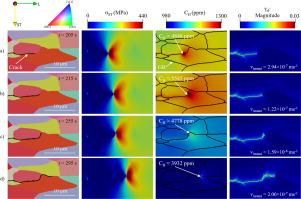用化学-力学相场耦合损伤模型模拟铝合金氢控制裂纹扩展动力学
IF 8.3
1区 材料科学
Q1 MATERIALS SCIENCE, MULTIDISCIPLINARY
引用次数: 0
摘要
7xxx系列铝合金的环境辅助开裂(EAC)涉及多种物理现象之间的相互作用,最终影响关键部件的使用寿命。在这项工作中,我们提出了一个新的模型来研究7xxx系列合金中的EAC,该模型在多物理场模拟框架DAMASK中实现。化学-力学模型通过位错、晶界(GB)和裂纹尖端应力场的微观组织捕获氢,将表面氧化和输运导致的裂纹尖端氢生成与晶体塑性控制的晶间裂纹扩展耦合在一起。采用真实晶粒结构进行了大规模模拟,为7xxx系列铝合金中与晶间EAC相关的主要速率控制过程提供了新的见解。该模型能够再现不同加载条件下实验测量的裂纹速度。参数化研究表明,裂纹扩展速率除受GB网络形貌控制外,还受裂纹尖端产氢控制,远程扩散对裂纹扩展速率的影响可以忽略不计。此外,裂纹尖端氧化产生的氢总量似乎比峰值生成速率更显著。本文章由计算机程序翻译,如有差异,请以英文原文为准。


Simulating hydrogen-controlled crack growth kinetics in Al-alloys using a coupled chemo-mechanical phase-field damage model
Environmentally Assisted Cracking (EAC) of 7xxx series aluminium alloys involves interactions between multiple physical phenomena, which ultimately influence the in-service life of critical components. In this work, we present a new model to study EAC in 7xxx series alloys, which is implemented in the multiphysics simulation framework, DAMASK. The chemo-mechanical model couples crack tip hydrogen generation, resulting from surface oxidation, and transport, with crystal-plasticity-governed intergranular crack propagation, through the microstructural trapping of hydrogen at dislocations, grain boundaries (GB), and crack tip stress fields. Large-scale simulations with realistic grain structures have been performed to provide novel insight into the dominant rate-controlling processes associated with intergranular EAC in 7xxx series aluminium alloys. The model was able to reproduce experimentally measured crack velocities under different loading conditions. Parametric studies indicate that, in addition to the GB network morphology, the crack growth rate was controlled by hydrogen generation at the crack tip with long-range diffusion having negligible influence. Additionally, the total hydrogen generated through crack tip oxidation appears to be more significant than the peak generation rate.
求助全文
通过发布文献求助,成功后即可免费获取论文全文。
去求助
来源期刊

Acta Materialia
工程技术-材料科学:综合
CiteScore
16.10
自引率
8.50%
发文量
801
审稿时长
53 days
期刊介绍:
Acta Materialia serves as a platform for publishing full-length, original papers and commissioned overviews that contribute to a profound understanding of the correlation between the processing, structure, and properties of inorganic materials. The journal seeks papers with high impact potential or those that significantly propel the field forward. The scope includes the atomic and molecular arrangements, chemical and electronic structures, and microstructure of materials, focusing on their mechanical or functional behavior across all length scales, including nanostructures.
 求助内容:
求助内容: 应助结果提醒方式:
应助结果提醒方式:


